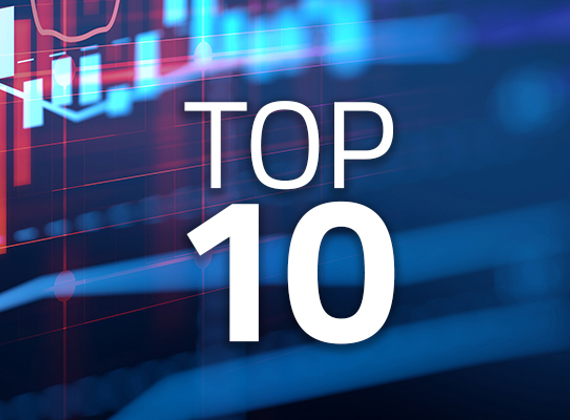Insights
Sprott Insights offers unique analyses and perspectives from the firm’s leading experts on key topics in precious metals and critical materials.

Video
Sprott on Metals: Today's Opportunities in Gold, Silver, Uranium and Copper
Jacob White meets with Asset TV to discuss Sprott’s focus on precious metals and critical materials, underscoring their rising importance across energy, technology and national security. White notes that 2025 has seen record highs for gold, silver and copper prices, alongside sustained supply deficits that are driving strong investor interest.

Video
Nasdaq Just for Funds: Sprott’s Steve Schoffstall on METL
Sprott’s Steve Schoffstall joins Nasdaq’s Just For Funds to discuss the Sprott Active Metals & Miners ETF (METL) — the only actively managed ETF providing diversified exposure to both critical and traditional metals miners driving the global energy transition.

Sprott Precious Metals Report
The Debasement Trade Broadens Across Precious Metals
In October, gold closed above $4,000 and silver hit record highs amid growing strategic demand, signaling a sustained shift away from fiat-based assets. Major developed economies are increasingly operating under fiscal dominance, driving investors toward hard assets like gold and silver.

Video
Gold Mining Equities: There's Still Room in the Trade
Gold has recently climbed to record highs. In this episode of Metals in Motion, Steve Schoffstall, Director of ETF Product Management at Sprott, joins Thalia Hayden @etfguide to explain why gold is performing well, and why the gold mining trade might still have room for investors to make their move.

Sprott Webcast Replay
Going Beneath the Surface: Active Management in Metals & Mining ETFs
Join Sprott’s expert team for an exclusive webcast replay exploring the powerful forces reshaping the metals and mining landscape, from surging energy demand and AI growth to tightening supply chains. Discover how Sprott’s active, research-driven ETF approach helps investors navigate volatility, and learn more about GBUG and METL.

Sprott Gold Report
Dips: The Rx for Acrophobia
With gold and silver reaching new all-time highs, we believe there is still opportunity in both the physical and miners markets. We see structural drivers (central bank demand, inflation resilience and declining trust in fiat currencies) that continue to support long-term allocations to gold and silver.

Sprott Precious Metals Report
Gold Leads as Faith in Fiat Falters
Gold surged to record highs as fading confidence in fiscal and monetary policy drove investors toward hard assets. With long-term yields rising and central banks turning increasingly accommodative, markets are signaling a loss of faith in fiat currencies, fueling gold’s breakout and silver’s potential squeeze.

Sprott Precious Metals Report
Challenges to Fed Autonomy Strengthen Case for Gold
Gold has topped another all-time high above $3,600 per ounce, while silver has reached $41, its highest level since 2011. Both metals may be among the strongest-performing asset classes for the year. We explore how erosion of Fed independence heightens policy risk, reinforcing the strategic role of gold and silver.

Video
The Key Drivers of Demand and Volatility in the Precious Metals Space
Nasdaq Trade Talks features Sprott’s Steven Schoffstall and the World Gold Council’s Joe Cavatoni on the key forces driving gold, silver and critical materials, from central bank demand to industrial growth and their role in portfolio diversification.

Sprott Gold Report
A Cure for Financial Dementia
In our view, market euphoria and collective amnesia have left gold miners overlooked despite record profits, soaring margins and aggressive shareholder returns. Gold mining equities are still stuck at bargain basement valuations, and we unabashedly continue to pound the table for precious metals equities and bullion alike.

Sprott Precious Metals Report
Gold Miners Shine in 2025
Gold and silver are up over 25% in 2025, with mining stocks surging more than 50%, yet still undervalued. We see continued upside amid inflation, geopolitical risks and strong fundamentals.

Sprott Precious Metals Report
Gold and Silver Bull Run Continues
Gold and silver have been strong performers in 2025, with both metals up over 25% YTD as global instability drives demand for safe haven assets. Central banks are shifting away from the U.S. dollar, while silver’s breakout suggests a potential supply squeeze ahead.

Sprott Precious Metals Report
Gold Gains Ground as Faith in the Dollar Erodes
Gold continues its rally as fading confidence in U.S. fiscal policy and the U.S. dollar drives demand for real assets. As we publish, silver is breaking out above $35, supported by structural supply deficits, renewed investor interest and mounting macroeconomic pressures.

Sprott Precious Metals Commentary
A Shaky U.S. Dollar Boosts Gold’s Role as an Alternative Reserve Asset
Gold is gaining prominence as a reserve asset due to a weak U.S. dollar and declining U.S. financials, reaching record highs while equities and bonds fell. We believe this positions gold as a potential anchor for a multi-asset reserve system. Given silver’s correlation to gold, we believe its monetary value will reassert itself in time.

Interview
Sprott CIO on Gold/Silver Miner Selection and Silver Outlook
James Connor of Bloor Street Capital speaks with Maria Smirnova, Sprott CIO, about the firm’s approach to gold and silver miner selection. Smirnova remains bullish on silver, citing a deep supply deficit and its essential role in electrification, despite prices lagging gold due to weak central bank demand and stagnant supply.

Video
Nasdaq’s Just for Funds: Introducing the Sprott Active Gold & Silver Miners ETF (GBUG)
Steve Schoffstall recently joined Nasdaq’s Just for Funds to discuss the launch of the Sprott Active Gold & Silver Miners ETF (GBUG), the only actively managed ETF focusing on gold and silver mining companies. Given current market volatility, gold is proving its value as a portfolio stabilizer, while investors may benefit from diversification and the flexibility of an active strategy to navigate the complexities of the mining sector.

Video
Why Does a Pure-Play Strategy Matter in Silver Miners?
SLVR is a silver mining and physical silver ETF that offers a pure-play strategy that allocates approximately 70% to silver-focused companies. SLVR offers investors a targeted and differentiated way to gain meaningful exposure to silver.

Shifting Energy
Safe Havens: The Enduring Stability of Precious Metals in Turbulent Times
In this episode of Shifting Energy (Season 2), Steve Schoffstall, Director, ETF Product Management and John Kinnane, Director, Key Accounts at Sprott Asset Management, chat about how investors are navigating bumpy markets and global trade wars with assets like gold and silver.

Sprott Gold Report
The Return of Exter’s Inverted Pyramid
Gold has been rising on strong official sector demand, fueled by concerns over the U.S. dollar and global instability. While Western investors have focused on potentially overvalued stocks, gold and mining equities offer potential upside as other assets struggle.

Sprott Q1 Precious Metals Report
Gold's Strength Amid a Crisis of Confidence
Gold's record-breaking rally in Q1 2025 reflects mounting investor anxiety over stagflation, policy volatility and a fraying global economic order. U.S. tariffs and policy unpredictability have elevated the risk of stagflation, fueling demand for gold as the lone liquid safe-haven asset. We also believe silver is potentially poised to break out.

Sprott Webcast Replay
A Closer Look at Gold and Silver, Metals and Miners
Gold and silver provide a powerful blend of potential wealth preservation, inflation mitigation and portfolio diversification. This webcast provides insights from John Hathaway and Maria Smirnova on the key technical drivers influencing gold, silver and precious metals mining equities.

Shifting Energy
Global Trade Wars: Unraveling the Impact on Critical Materials Markets
In this episode of Shifting Energy, Thalia Hayden interviews Steven Schoffstall, Director, ETF Product Management at Sprott Asset Management about how the global energy shift and market volatility are impacting precious metals and critical materials. Schoffstall provides valuable insights into what's happening with gold, silver, uranium and copper.

Interview
Trump Tariffs: Disruption or Opportunity?
Are tariffs set to disrupt gold, silver and uranium markets? Find out how potential trade barriers could impact prices and create arbitrage opportunities. Kitco’s Senior Mining Editor and Anchor Paul Harris interviews John Ciampaglia, CEO of Sprott Asset Management, at the 2025 BMO Global Metals, Mining & Critical Minerals Conference.

Special Report
GBUG and The Case for Active Management
Sprott Asset Management has launched GBUG which seeks long-term appreciation through value-oriented, contrarian investing. Sprott's active management team looks to capitalize on the wide dispersion of returns within the mining sector and the potential for silver to catch up to gold's rise.

Special Report
Top 10 Themes for 2025
What forces will shape the markets in critical materials and precious metals in 2025 and beyond? We identify 10 critical macro and market themes investors should watch in the coming year.

Sprott Gold Report
Recalibrating Our Crystal Ball
Gold was a strong performer in 2024, gaining 27.22% to end the year at $2,624.50, fueled by geopolitical tensions, central bank purchases and bond market struggles. These strong gains occurred with negligible participation or interest from investors in North America or Europe. Key catalysts for a gold rally could include stock or cryptocurrency downturns, bond market disruptions or a U.S. dollar reset.

Interview
Real Assets in Focus: Gold, Silver, Copper and Uranium
Unlock the power of real assets investing with Sprott’s Masterclass video. Dive into gold, silver, copper and uranium with industry experts Ed Coyne, Ryan McIntyre and Steve Schoffstall as they reveal strategies to navigate global uncertainties and identify opportunities. Discover how to leverage precious metals and critical materials to potentially build a resilient, future-ready portfolio.

Interview
Why Tech & Big Investors Are Turning to Uranium & Gold
John Ciampaglia, CEO of Sprott, joins James Connor to discuss why gold is increasingly viewed as a safeguard against economic uncertainty and why uranium has become essential to powering big tech's ambitious AI expansion.

Sprott Q3 Precious Metals Report
Gold and Silver Enjoy Continued Rally
Gold and silver prices surged in Q3 2024, driven by central bank buying and macroeconomic factors. While gold experienced a historic price increase, silver's price was influenced by both its precious metal value and industrial demand. YTD through September 30, gold is up 27.71% and silver has gained 30.95%.

Sprott Webcast Replay
Investing in Critical Materials: A Diversified Approach to a Long-Term Opportunity
In our webcast with Nasdaq, John Ciampaglia discusses the rapid emergence of technologies like AI, the race to upgrade power grids, continuing global decarbonization goals and growing middle classes. He gives an overview of how the critical materials behind energy—such as uranium, copper, nickel, lithium and more—are likely to remain growth-oriented investment opportunities for the long term, and how to invest in them in a single allocation.

Sprott Q2 Precious Metals Report
Gold’s Record-Setting Quarter and Silver’s Resurgence
Gold has been on the move since Q2 ended, after having gained 12.79% year-to-date as of June 30, gold's best six-month start since 2020. Gold enjoyed strong support from central bank buying. Silver closed Q2 at $29.14, its highest quarterly close since Q3 2012. Silver was supported by the gold breakout and global monetary expansion policies.

Shifting Energy
Uncovering Big Opportunities and Demand in Nickel for Investors
In this episode of Shifting Energy (Season 1), Thalia Hayden of etfguide talks with Steve Schoffstall, Director of ETF Product Management at Sprott Asset Management, about the nickel growth story, what's driving it and the investment opportunities now and ahead.

Interview
Gold Outlook with John Hathaway
What will take the gold price higher? John Hathaway, Senior Portfolio Manager, provides his thoughts on why gold isn't moving and what will take it higher.

Sprott Webcast Replay
Gold and Silver: Precious Metals On the Move
Replay our webcast, focused on gold and silver, and featuring John Hathaway and Maria Smirnova. Gold is enjoying strong support from central bank buyers like China, and silver is benefitting from increased demand for PV solar panels.

Sprott Q1 Precious Metals Report
Gold Is on the Rise and Reaches All-Time High
Gold reached an all-time closing high and is up 8.09% YTD (as of 3/31/2024) after rising 13.10% in 2023. We believe several fundamental factors are in place for gold to move higher, in particular, strong central bank buying. We also see three drivers for a higher silver price: 1) silver tracks rising gold due to central bank buying, 2) reflation trade and 3) increased solar panel demand.

Special Report
Top 10 Themes for 2024
What forces are likely to drive energy transition materials and precious metals markets in 2024 and over the next decade? We discuss 10 critical macroeconomic and market-specific themes ranging from deglobalization and climate policy to the new commodity supercycle and a potential silver price breakout.

Interview
The Energy Transition to Uranium and Battery Metals
Ed Coyne, Senior Managing Partner, sits down with Gillian Kemmerer of Asset TV to discuss the energy transition to uranium and other battery metals, and what investors should take into consideration in this space. He also shares Sprott's outlook on gold.

Sprott Precious Metals Report
Central Banks Support Gold & Solar PV Demand Buoys Silver
Despite a pullback on gold investments, demand from sovereigns and central banks remains unwavering. Over the past decade, China has been committed to bolstering its gold reserves to enhance its economic and geopolitical standings. Silver is likely to be in high demand as the energy transition expands, given it is critical to solar PV panel technology, EV batteries and 5G cellular service.

Sprott Precious Metals Report
Central Banks Flex Gold Market Muscle
In the first half of 2023, the gold bullion price rose by 5.23% despite competition from a euphoric equity market. Even with contrasting approaches, central banks and investment funds became the main players shaping the gold market in the first half of the year. Central bank buying drove demand, and gold is reverting to its historical role as a significant reserve asset as central banks seek to diversify amid geopolitical uncertainties.

Sprott Precious Metals Report
Geopolitical Risks Enhance Gold’s Role as a Reserve Asset
Gold attempted to breakout above $2,050 in early May before drifting lower as the U.S. debt-ceiling drama deepened and the U.S. dollar strengthened. At the same time, global central banks have been accumulating gold at a record pace. This highlights gold's role as a neutral reserve asset that has the potential to mitigate increasing counterparty risks amid escalating geopolitical tensions.

Sprott Precious Metals Report
Gold Rides Higher on Recession Fears
The gold market continues to be bullish as the probability of a recession rises, regional banking stress resurfaces and the Fed seems determined "get inflation down to 2%, over time". Globally, we are entering a more challenging period featuring subpar economic growth, increasing risks to systematic financial stability, stubbornly high inflation and rising geopolitical risks. Against this backdrop, we believe gold should perform well, even if the U.S. debt ceiling disaster is averted.

Sprott Precious Metals Report
Gold Bulls Run Faster as Fed Tackles Banking Crisis
In March, gold posted its highest monthly close since July 2020 and rounded out a solid Q1 2023 gain of 7.96%. Gold is now up 21.38% from last autumn's low (9/26/22) following the most aggressive central bank purchases in decades and gold investment flows catalyzed by the U.S. banking crisis. We are very optimistic given that many significant long-term bullish macro factors for gold have become stronger, while some shorter-term cyclical gold bearish factors have faded.

Sprott Precious Metals Report
First Gold Dip Since Central Bank Buying Spree
Gold fell in February, closing the month at $1,827 in a correction characterized by a stall in buying, but not selling. Since gold's autumn 2022 low of $1,622, global central banks have been buying gold at record rates; more than three times their long-term averages. The current scale of central bank buying is massive — an annualized rate of 1,724 tonnes vs. an average of 512 tonnes over the past decade. Central bank gold purchases as a percentage of global gold demand have also tripled to 34% from their average of 11% over the past several years.

Sprott Precious Metals Report
2023 Top 10 Watch List
This year’s top 10 list offers Sprott’s thoughts on what will likely drive markets in the coming year and decade, from a macro perspective and the vantage of our asset classes: Precious Metals and Energy Transition Materials. We believe the global clean energy transition will grow more urgent as energy markets continue re-ordering and energy security becomes synonymous with national security. The signposts point to a commodity-intensive, inflationary and capital-intensive decade where energy transition materials and precious metals will become far more valued than in the prior market regime.

Educational Video
Gold: A True Store of Value
Throughout history, gold has played a prominent role in the advancement of human civilization. Seen as a representation of the sun, of the gods and of true value, gold is a form of real money without counterparty risks. Symbol Au, atomic number 79, gold has been used to adorn the tombs of the great pharaohs and to help power spacecrafts that extend the horizons of humanity’s domain. Learn about gold’s culture, uses and history.
Important Disclosures
An investor should consider the investment objectives, risks, charges and expenses of each fund carefully before investing. To obtain a fund’s Prospectus, which contains this and other information, contact your financial professional, call 1.888.622.1813 or visit SprottETFs.com. Read the Prospectus carefully before investing.
Exchange Traded Funds (ETFs) are considered to have continuous liquidity because they allow for an individual to trade throughout the day, which may indicate higher transaction costs and result in higher taxes when fund shares are held in a taxable account.
The funds are non-diversified and can invest a greater portion of assets in securities of individual issuers, particularly those in the natural resources and/or precious metals industry, which may experience greater price volatility. Relative to other sectors, natural resources and precious metals investments have higher headline risk and are more sensitive to changes in economic data, political or regulatory events, and underlying commodity price fluctuations. Risks related to extraction, storage and liquidity should also be considered.
Shares are not individually redeemable. Investors buy and sell shares of the funds on a secondary market. Only “authorized participants” may trade directly with the fund, typically in blocks of 10,000 shares.
The Sprott Active Metals & Miners ETF, Sprott Active Gold & Silver Miners ETF and the Sprott Silver Miners & Physical Silver ETF are new and have limited operating history.
Sprott Asset Management USA, Inc. is the Investment Adviser to the Sprott ETFs. ALPS Distributors, Inc. is the Distributor for the Sprott ETFs and is a registered broker-dealer and FINRA Member. ALPS Distributors, Inc. is not affiliated with Sprott Asset Management USA, Inc.
